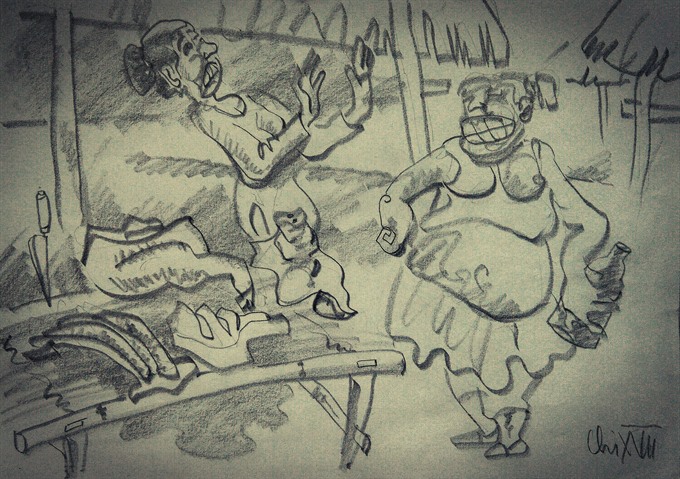 Talk Around Town
Talk Around Town

A video spreading via Facebook that shows a woman, appearing too hurt to cry, sitting next to a pile of pork covered in black liquid quickly shocked many people over the past few days.
 |
by Khánh Vân
A viral Facebook video showing a woman, appearing too hurt to cry, sitting next to a pile of pork covered in black liquid shocked many viewers over the past few days.
Her pork was doused in a mix of sewage water and engine lubricant by two other vendors after they accused her of ‘dumping’ the meat price at a market in the northern city of Hải Phòng.
However, it did not discourage consumers; they rushed to her store to buy the remaining uncontaminated meat.
The attackers were summoned by the police and will face criminal charges for destroying others’ assets. And, to many people’s surprise, the victim proposed local police mitigate the penalty for the attackers.
The story has a happy ending, but it has raised many questions about a broader concern: the remarkable drop in the pork price, which has caused major losses for farmers across the country.
The price of pork has decreased since early this year. In recent days, it has dipped to a record low--and also the lowest in the world. Pig on the hoof is sold at VNĐ25,000-VNĐ28,000 (US$1.11-1.24) per kilogramme.
These days, the term “save the pigs” has widely appeared via mass media, and it has even become a campaign launched by the Ministry of Agriculture and Rural Development to rescue farmers from losses caused by dropping prices. People have been asked to consume more pork and prioritise domestic pork.
But is it effective enough?
The victim in the story said she only sold pork for a few days, while the pig farm run by her family suffered big losses from declining live pig prices.
She was able to sell it at only between VNĐ20,000 to VNĐ50,000, roughtly $1-$2, per kilogram, much cheaper than other vendors in big cities like Hải Phòng, Hà Nội and HCM City.
“No one wants to sell meat at dirt cheap prices, but sometimes they have no choice,” she said.
So why do many farmers like her, who used to work at their own farm and stick around their own villages, still dare to step in the retail market to sell their pork in spite of such risks?
While prices of live pigs keep dropping and farmers have lost of millions of đồng for each pig, consumers in urban areas, particularly in big cities, still have to buy meat at a much higher prices.
“The price of meat at markets does not decrease much. I still buy meat at a price of VNĐ70,000-80,000 per kg,” said Hoàng Thu Hạnh from Cầu Giấy District.
“It is unreasonable, as the price of live pigs has continued to drop over the past months,” she said.
Why does the situation still occur, while market watch forces regularly inspect retailers? The lack of responsibility in market management led to the illogic of the market. It is the market rule that price of meat in the retail market will drop when there is surplus supply of pork.
In this case, does the rescue measure benefit farmers or only benefit retailers--while farmers still have to sell pig at low prices?
So “rescuing the pigs” is not enough.
The rescue measures are only band-aid solutions, and they do not address the oversupply problem. Therefore, the problem of dropping farm produce prices is repeated year after year.
The Ministry of Industry and Trade estimates the country will have a surplus of 200,000 tonnes of pork this year. If the glut is not addressed, many pig breeders, including large farms, are likely to go bankrupt--and animal feed, veterinary care, and slaughter and pork trading businesses will suffer badly.
This year alone, the country has had to scramble to settle agriculture-related oversupply problems.
In February banana farmers in several provinces were hit as prices plummeted from VNĐ14,000-17,000 per kilogramme to VNĐ1,000-3,000.
In April, several campaigns were launched to rescue watermelon farmers in some localities, who suffered severe losses after being unable to sell their harvests.
The farmers themselves are partly blamed for the problem, when many rush to grow items that fetched high prices the previous season without considering if prices would remain high and without acknowledging warnings from the Government. Most have little or no knowledge of the local market, global demand or price trends.
Đoàn Thị Chải, Deputy Director of northern Hưng Yên Province’s Agriculture and Rural Development, said many farmers still produce or grow farm products based on their perception, not on the supply-demand rules of the market.
Rescuing farm products was needed, but it’s a temporary solution and should only be applied once or twice, she said.
If the solution keeps being employed, many farmers will form the psychology of “relying on others” whenever there is an oversupply of farm products, she said.
Chairman of the National Assembly Committee for Culture, Education, Youth and Children Phan Thanh Bình said at a meeting of the NA Standing Committee on Monday that the rescue measure showed the market management passivity of relevant ministries and agencies.
If no sensible measures are taken, the story will only be repeated.
To help settle the problem, the Government and relevant ministries should take comprehensive measures: such as providing farmers with enough information about the market to enable them to make timely adjustments, ensuring supply and demand are balanced, changing the entire agricultural process from market forecast and production planning to harvesting and consumption and diversifying the market.
A system to forecast demand for and prices of farm produce in the domestic and overseas markets is an imperative for the ministries in order to help localities regulate their production plans.
We cannot wait until such situation happen and call on the whole society to jump in to rescue farmers. Prevention is better than after-the-fact treatment. — VNS




